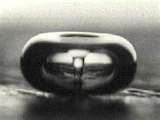 In the blog Cavitation 101, cavitation in liquids was described as the backbone of ultrasonic cleaning. Cavitation by itself, however, is not the end of the story. Although cavitation is the backbone, the real work is accomplished by the implosion of cavitation bubbles.
In the blog Cavitation 101, cavitation in liquids was described as the backbone of ultrasonic cleaning. Cavitation by itself, however, is not the end of the story. Although cavitation is the backbone, the real work is accomplished by the implosion of cavitation bubbles.
Cavitation bubbles are, in essence, pockets of vacuum or vapor of the surrounding liquid that are supported ONLY by the negative pressure or rarefaction of the sound wave surrounding them. Since sound waves travel through the liquid, an area of rarefaction is replaced with a area of pressure or compression as the sound wave moves on. The cavitation bubble, in some cases, may collapse after a single cycle while in others the cavitation bubble, subjected to alternating compression and rarefaction, starts to oscillate in resonance with the sound wave and grows larger with each passing sound wave until it finally becomes large enough to be unstable. In the blog What is Resonance?, the phenomenon of resonance growing over many sound wave cycles was described. In any event, when the cavitation finally does reach a condition of instability (over a single or many sound wave cycles) the result is a violent collapse or “implosion.” It is the implosion of cavitation bubbles that accomplishes ultrasonic cleaning.
Whan a cavitation bubble implodes, the inward rush of the bubble upon itself driven by the surrounding compression region of the sound wave results in a “collision” of sorts as the energy of the collapse is concentrated to a very small area. The resulting pressure at the center of the collapse has been estimated to exceed 10,000 PSI (Pounds per Square Inch) and may achieve temperatures exceeding 10,000° Fahrenheit. Similar conditions exist on the surface of the Sun! Although the above may seem scary, the high temperature and pressure exist for only an instant and are localized in a very small area at the focus of the implosion.

The energy of the collapsing cavitation bubble is often directed toward a nearby solid object which, fortunately for ultrasonic cleaning, is usually the object being cleaned.
There is a lot more to know about cavitation and implosion including what makes it work and what is likely to make it not work. These topics will be covered in some detail in upcoming blogs.
For those with additional interest, the PowerPoint animation imbedded below
Ultrasonic Cavitation and Implosion Power Point Show
shows how a cavitation bubble is created and implodes under the influence of passing sound waves. For best results, “save” the presentation on your desktop and then run it as a Power Point show. There are prompts at the bottom right of the screen to start the motion. If anyone has difficulty downloading or playing this Power Point, please contact me, jfuchs@ctgclean.com, and I’ll either email it to you or call you to see if we can get it to work. It is important for me to know if this method of presenting is going to work as many upcoming concepts will be illustrated with similar Power Point animations.
Also, please feel free to email me at the above address with any questions you may have about cleaning using ultrasonics or any of the other Cleaning Technology Group cleaning technologies. I will attempt to answer your question either in the blog or by return email.
– FJF –

 Water – De-ionized – Hints
Water – De-ionized – Hints  A Fond Farewell to John Fuchs
A Fond Farewell to John Fuchs  Millipore Testing – Evaluation by Particle Counting
Millipore Testing – Evaluation by Particle Counting  Tape Test for Cleaning Revisited
Tape Test for Cleaning Revisited